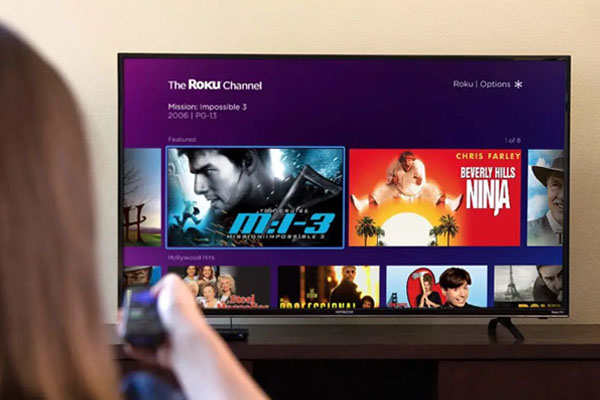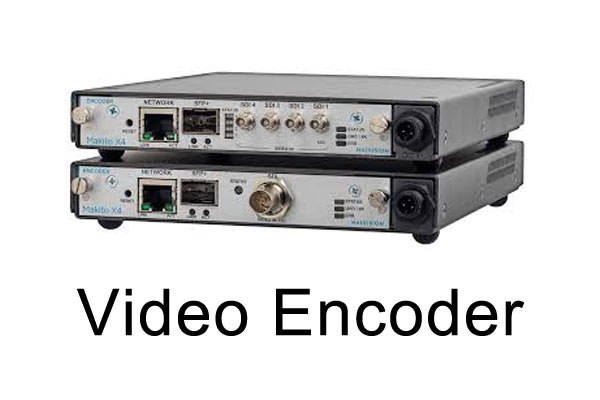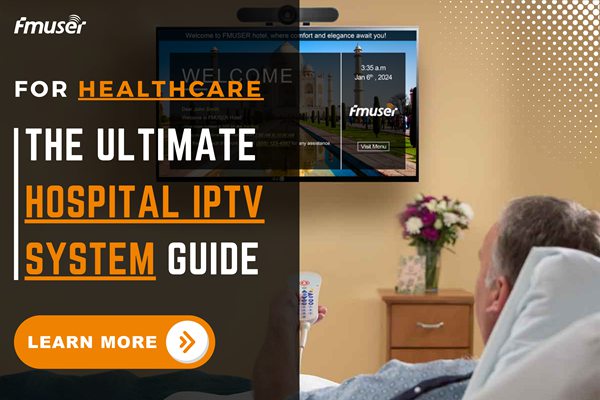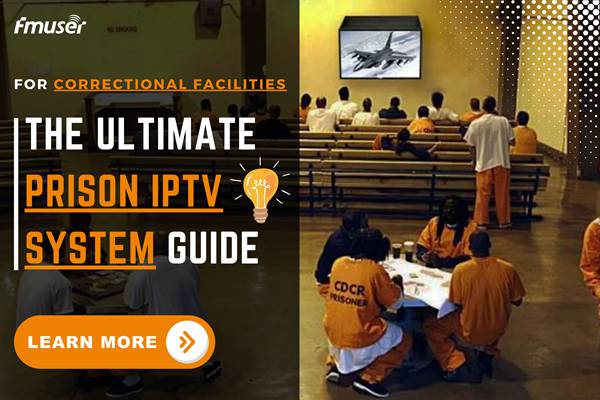
Hot tag
Popular search
The Ultimate Guide to IPTV Systems for Government | FMUSER
IPTV Government Solution refers to the implementation of Internet Protocol Television (IPTV) technology in government organizations to enhance communication, information dissemination, and accessibility.

Implementing IPTV in government organizations offers numerous benefits, including improved communication and collaboration, efficient information dissemination, cost savings, enhanced security, and increased accessibility.
This comprehensive guide aims to provide an overview of IPTV Government Solution, covering its basics, benefits, planning, implementation, content management, user experience design, maintenance, case studies, future trends, and more. Its objective is to help government organizations understand and successfully deploy IPTV solutions for their specific needs.
IPTV Explained
IPTV (Internet Protocol Television) is a technology that enables the delivery of live and on-demand video content to audiences over IP networks. Government institutions are increasingly adopting IPTV systems to modernize their communication solutions and provide critical services more efficiently to their stakeholders. Here's an overview of IPTV technology, its benefits, how it works, and specific use cases in the government sector:
Introduction to IPTV Technology, Benefits, and How it Works
IPTV, or Internet Protocol Television, is a digital television broadcasting protocol that enables the delivery of television content over IP networks. It leverages the power of the internet to transmit video, audio, and data in a more flexible and interactive manner. In this section, we will explore the fundamentals of IPTV and how it operates.
At its core, IPTV works by converting traditional television signals into digital data and transmitting them over IP networks. This allows users to access and stream content through various devices, including smart TVs, computers, smartphones, and set-top boxes.
The transmission of video, audio, and data in IPTV is facilitated through various protocols. One of the key protocols used is the Internet Protocol (IP), which ensures the efficient routing and delivery of data packets over the network. Another important protocol is the Real-Time Streaming Protocol (RTSP), which enables the control and delivery of streaming media.
IPTV also relies on various encoding and compression techniques to optimize the delivery of content. Video content is typically encoded using standards such as H.264 or H.265, which reduce the file size without compromising quality. Audio compression algorithms like MP3 or AAC are employed to efficiently transmit audio streams.
Additionally, IPTV systems employ middleware, which acts as the intermediary between the user and the content. Middleware manages the user interface, content navigation, and interactive features, allowing users to easily access and interact with the available content.
The architecture of an IPTV system consists of several key components. The headend is the central hub that receives, processes, and distributes the content to the viewers. It may include encoders, content servers, and streaming servers. Content delivery networks (CDNs) are utilized to optimize the delivery of content by caching and distributing it across multiple servers geographically.
To receive and decode IPTV streams, users typically utilize set-top boxes (STBs) or client devices. These devices connect to the network and display the IPTV content on the user's television or display. STBs may also provide additional functionalities such as DVR capabilities or interactive features.
In conclusion, understanding the basics and working principles of IPTV is essential for implementing and utilizing IPTV solutions effectively. This section has provided an overview of how IPTV utilizes internet protocol, the transmission of video, audio, and data, as well as the protocols and components involved in IPTV delivery.
The benefits of IPTV systems include:
- Cost savings as they can eliminate the need for multiple pieces of hardware and equipment.
- Reliable high-quality content delivery to audiences.
- Customization options as viewers can access only the content they want.
- Improved collaboration and communication between stakeholders.
- Security measures that enhance data protection.
IPTV systems work by encoding audio and visual data into digital signals that are then transmitted over IP networks as packets. These packets are reassembled at endpoints based on packet headers, enabling near-seamless delivery.
B. Key Components and Architecture of an IPTV System
An IPTV system comprises several key components that work together to enable the delivery of IPTV services. Understanding these components and their functions is crucial for the successful deployment of an IPTV solution. This section provides an overview of the key components and their roles within the IPTV architecture.
- Headend: The headend is the central component of an IPTV system. It receives various sources of content, such as live TV channels, on-demand videos, and other multimedia content. The headend processes and prepares the content for distribution to viewers. It may include encoders to convert the content into suitable formats and bitrates, content servers for storing and managing the content, and streaming servers for transmitting the content to end-users.
- Middleware: Middleware acts as an intermediary between the IPTV service provider and the viewers. It manages the user interface, content navigation, and interactive features. Middleware enables users to browse and select channels, access on-demand content, and utilize interactive services such as electronic program guides (EPGs), video-on-demand (VOD), and time-shifting functionalities. It plays a vital role in delivering a seamless and user-friendly IPTV experience.
- Content Delivery Network (CDN): A CDN is a geographically distributed network of servers that optimizes the delivery of content to viewers. It stores copies of the content in multiple locations, reducing latency and improving the streaming quality. CDNs distribute the content intelligently based on the viewer's location, enabling faster and more reliable content delivery. They play a crucial role in providing scalable and efficient IPTV services, especially during high-demand scenarios such as live events or popular broadcasts.
- Set-Top Boxes (STBs) and Client Devices: Set-top boxes (STBs) are devices that connect to the viewer's television or display to receive and decode the IPTV streams. STBs provide the necessary hardware and software capabilities to display the IPTV content, including video decoding, audio output, and user interaction. They may also offer additional features like DVR capabilities, interactive applications, and support for various connectivity options. Client devices, such as smart TVs, computers, smartphones, and tablets, can also serve as platforms for accessing IPTV services using dedicated apps or web-based interfaces.
The key components mentioned above work together in an IPTV system to provide a seamless viewing experience. The headend receives and prepares the content, middleware manages the user interface and interactive features, CDNs optimize content delivery, and STBs or client devices decode and display the IPTV streams.
Understanding the architecture and roles of these components is essential for designing and implementing a robust and scalable IPTV system. By leveraging the capabilities of each component, government organizations can deliver high-quality IPTV services to their viewers, enhancing communication and information dissemination within their operations.
C. Types of IPTV services relevant to government organizations
IPTV technology can significantly benefit governments by enhancing communication, increasing operational efficiency, and improving collaboration. Government organizations can use IPTV systems for various purposes, ranging from public information dissemination, training, and presentations, to remote meetings.
Use cases of IPTV systems in the government sector include:
- Live Streaming of Government Events: IPTV enables government organizations to live stream important events such as press conferences, town hall meetings, legislative sessions, and public hearings. By broadcasting these events in real-time, government entities can reach a broader audience, including citizens who are unable to attend physically. Live streaming facilitates transparency, public participation, and accessibility, enhancing communication between the government and its constituents.
- On-Demand Access to Archived Content: Government organizations often generate a vast amount of valuable content, including recorded meetings, educational resources, training sessions, and documentaries. IPTV allows for the creation of archives where citizens and government employees can access this content on-demand. This ensures that valuable information is readily available, promoting transparency, knowledge sharing, and efficient information dissemination within the government organization.
- Interactive Communication Platforms: IPTV can provide interactive communication platforms that allow government entities to engage with citizens in real-time. These platforms may include features such as video conferencing, chat functionality, and feedback mechanisms. Through interactive communication, government organizations can foster public involvement, gather citizen opinions, and address concerns more effectively. This promotes citizen engagement, strengthens trust in the government, and enables participatory decision-making processes.
- Educational IPTV Applications: Government organizations often play a role in providing educational resources to citizens. IPTV can be used to deliver educational content such as instructional videos, training materials, and e-learning programs. Government entities can leverage IPTV to create dedicated educational channels or on-demand libraries, enabling citizens to access valuable educational resources conveniently. This promotes lifelong learning, skills development, and empowers citizens with knowledge.
By utilizing these types of IPTV services, government organizations can enhance communication, improve information dissemination, and foster citizen engagement. Live streaming of events, on-demand access to archived content, interactive communication platforms, and educational applications all contribute to a more transparent and responsive government. These services empower citizens with access to relevant information, promote inclusivity, and facilitate active participation in the democratic process.
Top 5 Benefits
Government organizations, from federal agencies to local police departments, require effective and efficient mechanisms for delivering information to their respective audiences. This is why IPTV systems have become a popular solution for government entities, offering a range of benefits tailored to their unique requirements.
A. Increased efficiency in communication and broadcasting
IPTV systems provide government organizations with an efficient platform for broadcasting important messages and events. By using IPTV, government officials can create a live broadcast studio to share important news and events with citizens and stakeholders in real time. It can also be used for internal communication by the organizations, including distributing training sessions and conducting virtual meetings.
- Enhanced accessibility and inclusivity: IPTV ensures equal access to information by providing closed captions and audio descriptions for individuals with hearing or visual impairments, as well as delivering multilingual content to cater to diverse language preferences within the government organization and its constituents.
- Efficient dissemination of information: IPTV enables timely and accurate information delivery to constituents through features like emergency alerts, public service announcements, and on-demand access to archived content, providing citizens with the ability to retrieve relevant information conveniently.
- Improved collaboration and knowledge sharing: IPTV fosters collaboration among government agencies and departments through interactive features such as video conferencing and virtual workspaces, facilitating the sharing of educational resources, best practices, and training materials to promote knowledge sharing and professional development.
- Cost savings and resource optimization: IPTV reduces costs by leveraging efficient content distribution over IP networks, eliminating the need for physical media and streamlining content management processes, resulting in resource optimization within the government organization.
- Enhanced security and control: IPTV ensures secure content delivery by implementing encryption protocols and digital rights management (DRM) technologies, along with user authentication mechanisms and role-based permissions, providing enhanced security and controlled access to government information.
- Real-time monitoring and analytics: IPTV allows for monitoring viewership analytics to gain insights into content performance, audience engagement, and user preferences, enabling data-driven decision-making, while also collecting feedback and conducting surveys to assess the effectiveness of government programs and services for continuous improvement.
B. Streamlined content delivery
One of the main advantages of IPTV systems for government organizations is its ability to deliver content to a wide range of audiences with ease. IPTV offers the ability to deliver different types of media content such as live audio and video streams, on-demand videos, and recorded content. IPTV also allows government organizations to schedule content for specific times and dates, making it easy to manage multiple types of content for diverse audiences.
- Versatile content delivery: IPTV systems offer government organizations the ability to deliver various types of media content, such as live audio and video streams, on-demand videos, and recorded content, to a wide range of audiences.
- Efficient management of diverse content: IPTV allows government organizations to easily manage multiple content types for different audiences by scheduling content for specific times and dates.
- Centralized distribution: Streamlined content delivery through IPTV ensures that the right content reaches the intended audience effectively, improving information dissemination across the organization.
- Flexible customization options: Government organizations can adapt and tailor content based on the needs and preferences of different user groups, enhancing the relevance and engagement of the content.
- Enhanced accessibility: IPTV enables users to access and consume content conveniently from various devices, including smart TVs, computers, smartphones, and tablets, promoting wider accessibility and engagement.
- Reduced reliance on physical media: By delivering content digitally, IPTV reduces the need for physical media, such as DVDs or printed materials, resulting in cost savings and eco-friendliness.
- Increased reach and engagement: IPTV's scalable and efficient content delivery over IP networks allows government organizations to reach a larger audience, maximizing the reach and engagement of their content.
- Interactive viewing experience: IPTV supports interactive features like live chat, polling, and social media integration, fostering audience interaction and engagement for a dynamic and immersive viewing experience.
- Comprehensive content management capabilities: IPTV provides robust content management features, including content scheduling, categorization, and metadata tagging, ensuring efficient organization and retrieval of content for seamless delivery.
C. Improved stakeholder engagement
Government organizations are often tasked with keeping their stakeholders informed on policies, events, and initiatives. IPTV systems provide channels for reaching these stakeholders in a variety of ways. Government organizations can use IPTV to create channels for disseminating information, creating public service announcements, and broadcasting emergency alerts in times of crisis. Stakeholders can also actively participate in events using the interactive features of IPTV, like live polls and chat features.
- Diverse channels for information dissemination: IPTV enables government organizations to create dedicated channels for disseminating information, keeping stakeholders informed about policies, events, and initiatives.
- Public service announcements: Government organizations can utilize IPTV to create and broadcast public service announcements, ensuring important messages reach stakeholders promptly and effectively.
- Crisis communication: IPTV provides a reliable platform for broadcasting emergency alerts and critical information during times of crisis, facilitating rapid and widespread communication with stakeholders.
- Interactive engagement: Stakeholders can actively participate in events through IPTV's interactive features, such as live polls and chat features, fostering a sense of involvement and encouraging real-time engagement.
- Virtual town hall meetings: IPTV allows government organizations to host virtual town hall meetings, enabling stakeholders to participate remotely, ask questions, and provide valuable input, enhancing transparency and inclusivity.
- Increased accessibility for remote stakeholders: IPTV helps overcome geographical barriers by allowing stakeholders from remote locations to access and engage with government events and initiatives, promoting broader stakeholder participation.
- Efficient stakeholder feedback collection: IPTV's interactive features facilitate the collection of stakeholder feedback through surveys, polls, and chat features, enabling government organizations to gather valuable insights and make data-driven decisions.
- Enhanced two-way communication: IPTV enables government organizations to establish a direct and immediate communication channel with stakeholders, fostering a sense of transparency, openness, and responsiveness.
D. Cost-Effective
IPTV is a cost-effective solution compared to traditional means of distributing audiovisual content. For example, organizing an event that will host hundreds or thousands of people requires significant investment in renting a large venue, logistics, travel, and accommodation expenses for speakers or guests, preparation for materials such as brochures and pamphlets, or hiring a production team to record and edit the event for later distribution. An IPTV system will eliminate the majority of these costs while still achieving the same or greater reach and engagement.
- Reduced event expenses: Organizing large-scale events typically incurs substantial costs for venue rental, logistics, travel, accommodation, and production teams. With IPTV, these expenses can be significantly reduced or eliminated altogether, as events can be streamed virtually without the need for physical venues or extensive travel arrangements.
- Elimination of material costs: Traditional methods often involve the production of printed materials such as brochures and pamphlets. IPTV eliminates the need for these materials, reducing printing and distribution costs.
- Efficient content creation and distribution: IPTV simplifies the content creation process by providing a centralized platform for recording, editing, and distributing content. This eliminates the need to hire a separate production team, reducing associated costs.
- Scalable and cost-efficient content delivery: With IPTV, content can be delivered over IP networks, eliminating the need for costly physical distribution methods, such as DVDs or USB drives. This scalability allows for cost-effective content distribution to a large number of viewers.
- Greater reach and engagement at a lower cost: IPTV enables government organizations to reach larger audiences without incurring additional expenses for physical space, transportation, or accommodation. This cost-effective reach results in higher engagement and broader dissemination of information or messages.
- Flexibility for future scalability: IPTV systems can be easily scaled to accommodate growing audiences or changing demands, ensuring that the cost savings and efficiencies can be sustained as the organization expands.
E. Analytics and Data Tracking
Another significant benefit of IPTV systems is that it offers detailed analytics and data tracking capabilities that provide insights into viewership patterns, engagement levels, and other metrics. These data can be leveraged by government organizations to identify areas of interests or to improve their content delivery strategies.
- Viewer behavior analysis: IPTV analytics allow government organizations to track viewership patterns, including which content is most popular, how long viewers engage with specific content, and at what times viewers are most active. This information helps identify areas of interest and optimize content delivery strategies.
- Engagement measurement: IPTV data tracking enables the measurement of user engagement, such as interactions with interactive features, participation in live polls, and chat activity. This data helps gauge the effectiveness and impact of government programs, events, and initiatives.
- Performance assessment: IPTV analytics provide insights into the performance of content, channels, and programs. Government organizations can analyze metrics like viewer retention, drop-off rates, and viewership trends to evaluate the success of their content and make data-driven decisions for improvement.
- Content optimization: Leveraging analytics, government organizations can identify content gaps, preferences, and audience demands. This information drives content optimization strategies, allowing for the creation of more relevant and engaging content that resonates with viewers.
- Data-driven decision-making: IPTV data analytics serve as a valuable resource for government organizations to make informed decisions. By analyzing viewership trends, engagement metrics, and content performance, organizations can refine their strategies, allocate resources effectively, and tailor their communication to better serve their constituents.
- Continuous improvement: The availability of detailed analytics and data tracking enables government organizations to continuously evaluate and improve their IPTV initiatives. By monitoring key metrics, organizations can identify areas of success and areas for improvement to enhance the overall IPTV experience.
In conclusion, IPTV systems offer vast benefits for government organizations. The ability to efficiently broadcast real-time information, streamline content delivery, and improve stakeholder engagement makes IPTV an effective solution for delivering information across large and diverse areas of stakeholders. Furthermore, the reduced cost and tracking capabilities of IPTV make it an attractive option for forward-thinking government entities looking to work within tight budgets and improve efficiency.
FMUSER's IPTV Government Solution
FMUSER offers a comprehensive IPTV solution specifically designed for government organizations. Our IPTV system provides seamless integration with existing government systems, ensuring a smooth transition and enhanced operational efficiency. With our expertise and range of services, we aim to be your trustworthy partner in delivering the best IPTV solution tailored to your organization's needs.
👇 FMUSER's IPTV solution for hotel (also used in government, healthcare, cafe, etc.) 👇
Main Features & Functions: https://www.fmradiobroadcast.com/product/detail/hotel-iptv.html
Programme Management: https://www.fmradiobroadcast.com/solution/detail/iptv
👇 Check our case study in Djibouti's hotel (100 rooms) 👇
Our IPTV system comprises a wide array of components and services to support government organizations throughout their IPTV journey. We provide an IPTV headend that efficiently receives, processes, and delivers content, ensuring high-quality streaming to end-users. Our networking equipment enables robust and secure connectivity, guaranteeing reliable content delivery across your organization.
One of our key offerings is our technical support, where our experienced team stands ready to assist you at every step. We understand the unique requirements of government organizations and provide personalized guidance to help you customize, choose, and install the best IPTV solution. Our experts will work closely with your IT team, ensuring seamless integration with your existing systems and infrastructure.
We provide on-site installation guidelines, ensuring a smooth deployment process. Our team will be there to assist you in setting up the necessary hardware and software components, optimizing the configuration to meet your specific needs. We understand the importance of a hassle-free installation, and we strive to minimize any disruptions to your operations.
In addition to installation, we offer comprehensive testing and maintenance services. Our team will help you thoroughly test the IPTV solution to ensure it functions seamlessly within your existing systems. We provide ongoing maintenance and support to address any technical issues promptly, allowing you to focus on your core activities without worrying about technical glitches.
Our goal is to optimize your operation efficiency and improve the working experience throughout your organization's streaming lines. By leveraging our IPTV solution, you can streamline communication, enhance information dissemination, and provide a seamless user experience to your employees and constituents.
Partnering with FMUSER means gaining a long-term business relationship. We are committed to your success and growth. Our IPTV solution is designed to not only improve your internal operations but also enhance your clients' user experience. By delivering high-quality content and interactive features, you can foster engagement and trust with your constituents.
Choose FMUSER as your IPTV partner and unlock a world of possibilities for your government organization. Let us help you harness the power of IPTV to transform your operations, boost profitability, and deliver exceptional user experiences. Contact us today to explore how our IPTV Government Solution can revolutionize your organization.
Case Study
FMUSER is a leading provider of IPTV systems for governments and organizations worldwide, with comprehensive experience catering to the needs of medium and small-scale organizations. We have experienced teams of hardware and software engineers, project managers, and technology consultants to deliver reliable, scalable, and cost-effective IPTV systems for modern governments.
1. City Council of Easthampton
FMUSER provided an IPTV system to the City Council of Easthampton, Massachusetts, to live stream council meetings, provide on-demand video access to residents, and distribute other informational content. The system was integrated with the local CMS and broadcasting system to ensure seamless communication with all stakeholders. The IPTV system helped the City Council of Easthampton reach a wider audience and engage with constituents effectively.
2. School District of Oil City
FMUSER provided an IPTV system to the School District of Oil City, Pennsylvania, to broadcast live sports events, distribute school news, and educational material to students and teachers. The system was integrated with the school's ERP system, enabling efficient budget management and scheduling of equipment maintenance. The IPTV system helped the school district of Oil City engage with the community and provide a valuable educational resource.
3. City of Sedona
FMUSER provided an IPTV system to the City of Sedona, Arizona, to broadcast city hall meetings, provide on-demand video access to residents, and keep the community informed about local events. The system was integrated with the city's CRM system, enabling the city to keep in touch with residents and notify them of upcoming events. The IPTV system helped the City of Sedona build strong relationships with residents and reduce the communication barriers between the government and the community.
4. City of Elk River
FMUSER provided an IPTV system to the City of Elk River, Minnesota, to broadcast city council meetings and other public events to residents. The IPTV system was integrated with the city's network management system, allowing the city to monitor network traffic accurately and optimize network performance. The IPTV system helped the City of Elk River deliver timely information to residents and benefit from increased citizen participation.
5. Community College of Denver
FMUSER provided an IPTV system to the Community College of Denver, Colorado, to broadcast student events, educational material, and news updates. The IPTV system was integrated with the college's CMS and ERP systems, allowing efficient content management and budget management. The IPTV system helped the Community College of Denver provide essential educational material to students and establish itself as a modern and innovative educational institution.
6. City of Alameda Police Department
FMUSER provided an IPTV system to the City of Alameda Police Department in California, to assist with the training of police officers. The system was used to deliver virtual training sessions and simulations and provide access to educational materials and community outreach videos. The IPTV system was integrated with the police department's CRM system to provide immediate access to relevant video content for officers.
FMUSER has extensive experience delivering IPTV solutions across a range of sectors, including police and fire departments, emergency response agencies, public transportation agencies, and government contractors and vendors. By tailoring IPTV systems to meet the specific needs of each organization, FMUSER has revolutionized communication and content management for stakeholders. The effectiveness of IPTV systems is demonstrated through successful deployments that have improved staff training, education, public information, and procurement processes. FMUSER's expertise in delivering efficient IPTV solutions extends beyond the USA, with deployments across the globe to organizations such as universities and government agencies. With IPTV systems providing effective communication and collaboration, FMUSER demonstrates that they can assist across sectors worldwide.
Common Issues
IPTV systems have emerged as an invaluable tool for government organizations worldwide, enabling efficient communication and engagement with their stakeholders. However, they may encounter several technical issues that can undermine their effectiveness and mission-critical nature.
Here are some common IPTV system issues and their solutions for government organizations:
1. Network congestion and bandwidth issues
One of the most common IPTV system issues is network congestion and bandwidth limitations. Inadequate bandwidth can result in buffering, lag, and low-quality video experience.
Solution: A high-speed, bandwidth-efficient IPTV system is essential for government organizations. The bandwidth must be managed correctly to ensure a smooth streaming experience with no buffering or lag.
2. Inefficient content management and distribution
Managing, organizing, and delivering content efficiently can be a daunting task for government organizations. If not correctly managed, it can result in delays, missing content, or outdated information.
Solution: Government organizations should have a well-designed content management system (CMS) that can handle various types of data, including live streams and on-demand content. An efficient CMS with proper metadata management can provide comprehensive information and a quick search process that assists in improving overall content delivery.
3. Security and data protection
Government agencies handle sensitive data that requires a high level of security. Poorly secured IPTV systems can lead to unauthorized access to content, data breaches, and cyber-attacks.
Solution: IPTV systems should be configured with robust security measures that protect data during transmission and storage. Government organizations should invest in encryption and secure storage solutions that meet or exceed industry security standards.
4. Equipment maintenance issues
IPTV systems require regular maintenance of equipment, including broadcasting devices, servers, and network components. Equipment failures can result in disruptions to the IPTV system.
Solution: Government organizations should establish a comprehensive equipment maintenance schedule, with documentation of all system components. To ensure that the IPTV system is working optimally, the equipment should be routinely serviced by qualified experts.
In conclusion, IPTV systems are increasingly becoming an integral aspect of government communication and engagement with stakeholders. However, they face several technical issues that can significantly affect their functioning. By investing in high-speed, bandwidth-efficient IPTV systems, implementing a robust CMS, incorporating adequate security measures, and regularly maintaining equipment, government organizations can establish reliable and efficient IPTV systems. By doing so, they can increase communication and collaboration while informing communities and stakeholders about important issues.
System Planning
To ensure a successful implementation of an IPTV system for a government organization, careful planning is required. In this chapter, we discuss the key areas that need consideration while planning an IPTV system for government.
1. Assessing Organizational Needs and Requirements
In the initial phase, it is crucial to assess the specific needs and requirements of the government organization regarding the IPTV implementation. This involves conducting a thorough analysis of the organization's goals, objectives, and target audience. Engaging with stakeholders, including department heads and IT staff, will help gather valuable input and ensure alignment with organizational requirements.
2. Identifying Suitable IPTV Vendors and Solutions
Research and evaluate reputable IPTV vendors that specialize in government solutions. Consider factors such as vendor experience, track record, customer reviews, and their ability to meet specific government requirements. Request proposals from shortlisted vendors and review their offerings in terms of features, scalability, and compatibility with existing systems.
3. Designing an IPTV Infrastructure and Network
Collaborate with IPTV vendors and IT experts to design a robust infrastructure that supports the organization's IPTV goals. This includes determining network requirements such as bandwidth, network topology, and redundancy measures to ensure optimal performance. Integration with existing IT infrastructure, such as security protocols and firewalls, should also be considered during the design phase.
4. Determining the Necessary Hardware and Software Components
Working closely with IPTV vendors, identify the necessary hardware and software components required for the IPTV solution. Evaluate factors such as encoding devices, set-top boxes (STBs), servers, streaming protocols, middleware, and content management systems. Compatibility with the organization's existing hardware and software infrastructure should be ensured, while also considering scalability for future growth.
5. Establishing a Robust Content Management System
Develop a comprehensive content management strategy to efficiently organize, categorize, and deliver content within the IPTV system. This involves determining processes for content ingestion, metadata tagging, content scheduling, and content distribution to different user groups. Consider features such as content searchability, personalized recommendations, and content archiving to enhance the user experience and facilitate easy retrieval.
6. Incorporating Security Measures and Access Controls
Implement stringent security measures to protect the IPTV system and content from unauthorized access or piracy. This includes employing encryption protocols, digital rights management (DRM) solutions, and access controls to safeguard sensitive content. User authentication mechanisms, user roles, and permissions should be established to ensure appropriate access levels for different user groups, enhancing overall system security.
By following a comprehensive approach that includes assessing organizational needs, selecting suitable vendors, designing the infrastructure, determining hardware and software components, establishing a robust content management system, and incorporating stringent security measures, government organizations can successfully plan and implement an IPTV solution that meets their specific requirements.
System Installing
After completing the planning phase, the next step is to install the IPTV system for government organizations. In this chapter, we discuss the key areas that need attention during the installation process:
1. Hardware Installation
The first step in the installation process is to ensure that the IPTV system hardware is installed correctly. This includes the set-top-boxes (STBs), satellite dishes, dish mounts, encoders, decoders, IP cameras, and any other equipment needed for the system to function as intended. All hardware installations should be carried out by reputable vendors who have specific experience in installing IPTV systems.
2. Software Installation and Configuration
Once all hardware components are installed, the next step is to install and configure the software. The installation process involves installing the IPTV application software on every device within the organization, including computers, STBs, tablets, and smartphones. The configuration process involves setting up the software to work correctly within the organization's existing network. This is done by configuring each device to broadcast and receive content through the organization's network appropriately.
3. Network Configuration
The network configuration is crucial for the successful operation of the IPTV system. The organization should ensure that their network infrastructure and architecture meet the requirements of the IPTV system. This includes ensuring that the necessary bandwidth is available to support the incoming and outgoing traffic, setting up LANs and VLANs, and configuring VPNs where necessary.
4. Testing and Troubleshooting
After completing the installation and configuration process, the organization should test the IPTV system to ensure that it is working correctly. Testing should include checking that video streams and on-demand content are being delivered correctly to the intended devices, the quality of the video and audio is satisfactory as well as verifying that all interactive features are working correctly. The organization should also troubleshoot the system in case of any issues and document the problem and resolution for future reference.
5. User Training
After completing the installation process, the organization needs to provide user training to the end-users to familiarize them with the IPTV system's usage. The training should include an explanation of the system's features and operation, user interface, and scheduling tools used to create customized playlists and live broadcasting.
In conclusion, installing an IPTV system for government organizations requires careful planning, installation, and testing to ensure its successful operation. The organization must ensure that all hardware and software components are installed correctly and configured appropriately, the network infrastructure meets the IPTV system requirements, and thorough user training is provided. By following these best practices, the IPTV system will operate correctly and efficiently.
Content Management
1. Developing a Content Strategy and Categorization
To effectively manage content within the IPTV solution, it is crucial to develop a robust content strategy. This involves defining the organization's goals, target audience, and desired outcomes. Determine the types of content that will be included, such as live broadcasts, on-demand videos, educational resources, and public announcements. Establish a categorization system to organize content logically, making it easy to navigate and search.
2. Creating and Acquiring Relevant Content for Government Use
Creating original content and acquiring relevant content from trusted sources are vital for a comprehensive IPTV solution. Government organizations can produce content from their events, conferences, and training sessions. Additionally, they can partner with content providers or license content that aligns with their objectives. Ensure that the content adheres to regulatory requirements and copyright laws while maintaining high-quality standards.
3. Managing and Organizing Content Libraries
Efficient management and organization of content libraries are crucial for seamless content delivery. Implement a content management system that facilitates metadata tagging, version control, and content expiration management. Establish workflows for content ingestion, review, approval, and publishing to ensure a streamlined content management process. Implement access controls to protect sensitive content and ensure compliance with privacy regulations.
4. Personalization and Targeting Options for Different User Groups
Enhance user engagement by offering personalization and targeting options within the IPTV solution. Allow users to customize their content preferences, create playlists, and receive personalized recommendations. Implement targeting options to deliver specific content to different user groups based on roles, departments, or locations. This ensures that users receive relevant and tailored content, improving their overall experience with the IPTV system.
5. Ensuring Content Quality and Compatibility Across Devices
Maintaining content quality and compatibility across various devices is vital for a seamless viewing experience. Regularly assess content quality, including video and audio, to ensure optimal presentation. Optimize content delivery by employing transcoding and adaptive streaming technologies, allowing content to adapt to different bandwidths and devices. Test content compatibility across different devices, platforms, and screen sizes to ensure consistent performance and accessibility.
User Design
A. Designing an Intuitive and User-Friendly Interface
The user interface (UI) design plays a crucial role in ensuring a positive user experience within the IPTV solution. Design an interface that is intuitive, visually appealing, and easy to navigate. Consider user-friendly features such as clear menu structures, logical content categorization, and intuitive search functionalities. Prioritize simplicity and consistency to minimize user confusion and enhance overall usability.
B. Customization Options for Different User Roles
Government organizations often have diverse user groups with varying roles and responsibilities. Provide customization options within the IPTV solution to cater to these different user needs. Allow users to personalize their preferences, choose preferred content categories, and create customized playlists. This level of customization enhances user engagement and ensures that users can access content relevant to their specific roles and interests.
C. Implementing Interactive Features and Engagement Tools
Enhance user engagement by incorporating interactive features and tools within the IPTV solution. This may include features such as live chat, feedback mechanisms, polls, and surveys. Interactive elements encourage user participation, gather valuable insights, and promote interaction between government organizations and their constituents. These features foster an engaging and collaborative IPTV experience.
D. Enhancing Accessibility for Individuals with Disabilities
Accessibility is a crucial consideration in user experience design, ensuring that the IPTV solution is usable by individuals with disabilities. Implement accessibility features such as closed captions, audio descriptions, and screen reader compatibility. Adhere to accessibility standards and guidelines to ensure that the IPTV solution is inclusive and provides equal access to all users, regardless of their abilities.
By focusing on user experience and interface design, government organizations can create an IPTV solution that is intuitive, customizable, interactive, and accessible. Prioritizing an intuitive interface, providing customization options, implementing interactive features, and enhancing accessibility contribute to a positive user experience and encourage engagement within the IPTV system.
System Integrating
Integrating an IPTV system with other government systems is crucial for ensuring seamless communication, efficient operations, and effective data management. In this chapter, we discuss the key areas that require attention when integrating IPTV systems with other government systems.
1. Content Management System Integration
A content management system (CMS) is an essential tool that allows government organizations to create, manage, and publish content across all their communication platforms, including social media, websites, and mobile apps. By integrating IPTV systems with a CMS, the organization can streamline their content creation workflow and manage all their content centrally in one location. This integration ensures that all stakeholders receive accurate and up-to-date information, regardless of the communication channel used.
2. Enterprise Resource Planning Integration
Enterprise resource planning (ERP) systems enable government organizations to keep accurate track of their resources, including financial transactions, procurement, inventory, and other processes. By integrating IPTV systems with an ERP system, the organization can manage the scheduling and costs of IPTV-related expenditure, such as hiring content producers or maintenance staff.
3. Customer Relationship Management Integration
The customer relationship management (CRM) system helps government organizations manage their relationships with stakeholders, including citizens, contractors, and suppliers. Integrating IPTV systems with a CRM system enables the organization to provide stakeholders with relevant and targeted content, notifying them of upcoming events, news, and other important updates.
4. Network Management Integration
Efficient end-to-end management of a network infrastructure is crucial for the optimal functioning of an IPTV system. Integrating the IPTV system with the network management system enables the organization to monitor the network traffic and usage patterns, detect and resolve potential network faults, and ensure the overall network performance.
5. Broadcasting System Integration
In certain situations, government organizations require emergency broadcasting capability, such as public safety alerts or crisis management broadcasts. Integrating the IPTV system with the broadcasting system allows for a quick and efficient dissemination of alerts to all stakeholders.
In conclusion, Integrating IPTV systems with other government systems is essential for efficient communication and management of data. The integration of the IPTV system with a CMS, ERP, CRM, Network Management and Broadcasting System enables efficient data management, content management, process optimization, cost management, and effective emergency broadcasting. By following best practices outlined in this chapter, government organizations can ensure a seamless and productive integration of their IPTV system with other essential systems.
System Maintaining
Maintaining an IPTV system for a government organization is essential for ensuring its optimal functioning and long-term reliability. In this chapter, we discuss the key areas that require attention during the maintenance phase.
1. Regular System Updates
As with any software-based system, IPTV systems require regular updates to stay up-to-date with the latest technology and security protocols. The organization should regularly check for updates from the manufacturer or supplier of the IPTV system and install them promptly.
2. System Monitoring and Optimization
To ensure the IPTV system operates at its optimal level, the organization needs to conduct regular system monitoring to detect potential bottlenecks, errors, or other issues. The organization should keep track of the system performance, bandwidth utilization, incoming traffic, and other performance indicators. Additionally, the organization should optimize the system by regularly cleaning the database of outdated or irrelevant content, creating new content, and ensuring that the network infrastructure is functioning optimally.
3. User Support and Training
The organization should provide user support and training to their stakeholders for the ongoing successful use of the IPTV system. The organization should have a dedicated support team available to answer user inquiries, troubleshoot problems, and resolve issues promptly. The team should also guide the end-users in creating and publishing content.
4. Security Management
The IPTV system holds valuable and sensitive data, including video recordings, live broadcasts, and other content produced or shared for internal and external use by the organization. Therefore, Security management should be a top priority, and the organization should implement a security-first approach. They should configure the IPTV systems with the standard security protocols using firewalls, encryption, and virtual private networks (VPN). Regular security reviews, audits, and testing should also be conducted to ensure the system remains secure.
5. Hardware and System Maintenance
The hardware and system that make up the IPTV system also need regular maintenance. The organization should have a schedule for the maintenance of all system components, including the STBs, encoders, decoders, wires, and any other hardware. Maintenance schedules should include cleaning, inspection, repairs, and occasionally replacing components to prevent unexpected system errors or failures.
In conclusion, maintaining an IPTV system is crucial for its continued optimal operation for the government organization. This chapter discussed the key areas of system updates, system monitoring, user support, security management, and hardware and system maintenance. Implementing regular maintenance practices will ensure that the IPTV system remains reliable and provides the organization with the necessary tools to meet their media communication needs.
Conclusion
In conclusion, IPTV systems are becoming increasingly crucial tools for government institutions globally. They offer numerous benefits, such as enhancing communication, increasing operational efficiency, improving collaboration, and providing high-quality educational content delivery. FMUSER is a company that specializes in providing IPTV solutions to various institutions, including government organizations. By adopting these IPTV systems, governments can leverage their benefits to optimize their information dissemination channels, enhance operational efficiency, improve collaboration, and provide high-quality services to internal and external stakeholders. FMUSER provides a wide range of IPTV solutions designed to meet the needs of various government organizations. These solutions are customized to fit individual requirements and can be deployed on both hardware-based and software-based systems.
Don't miss out on the opportunity to leverage IPTV technology to optimize your services and provide the best possible experience to your stakeholders. Contact FMUSER today to learn more about how their experts can help you deploy IPTV systems that cater to your unique needs. By leveraging the advantages of IPTV systems, you can stay ahead of the curve, streamline communication channels, and improve your services' quality. Start enhancing your communication channels today!
Contents
Related Articles
CONTACT US


FMUSER INTERNATIONAL GROUP LIMITED.
We are always providing our customers with reliable products and considerate services.
If you would like to keep touch with us directly, please go to contact us



















